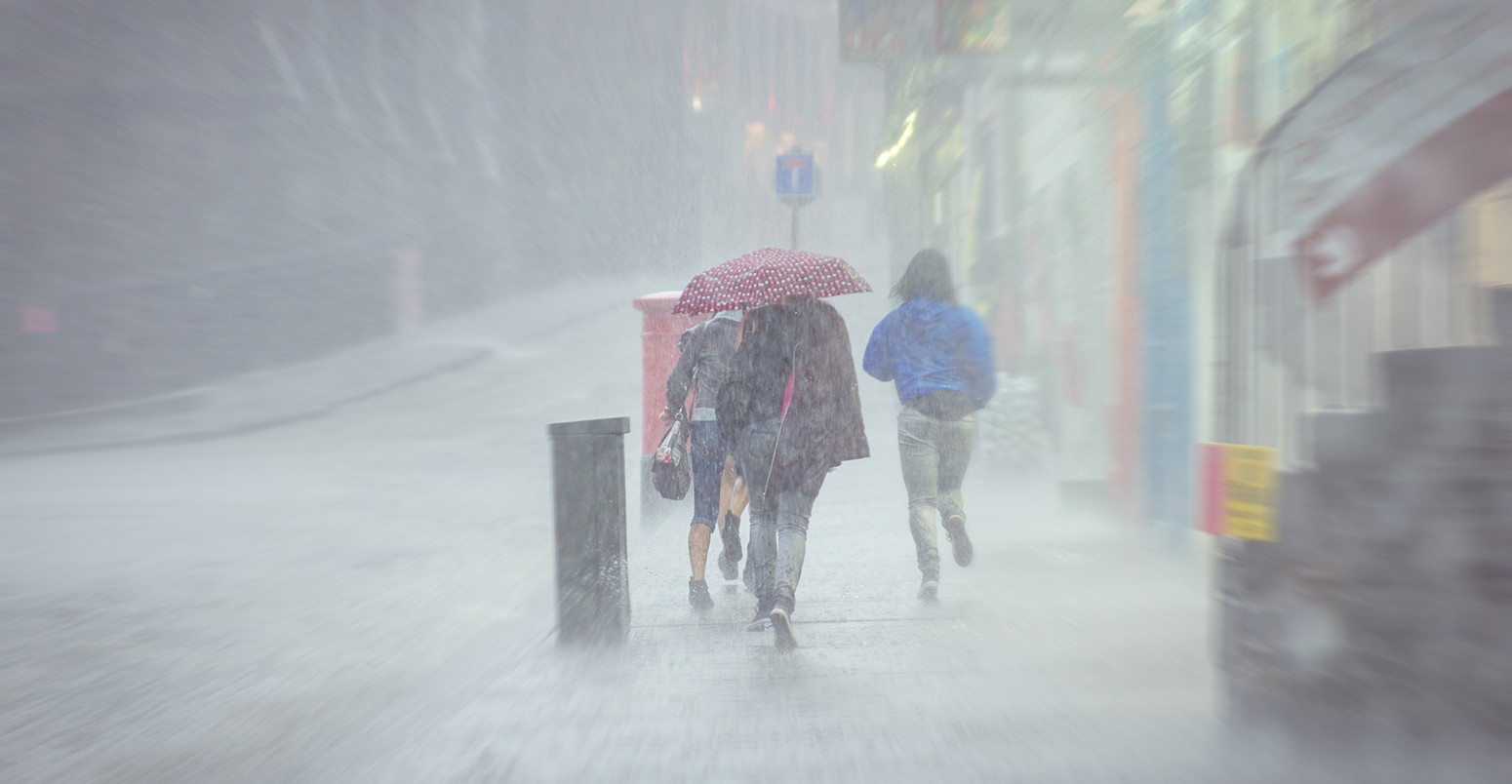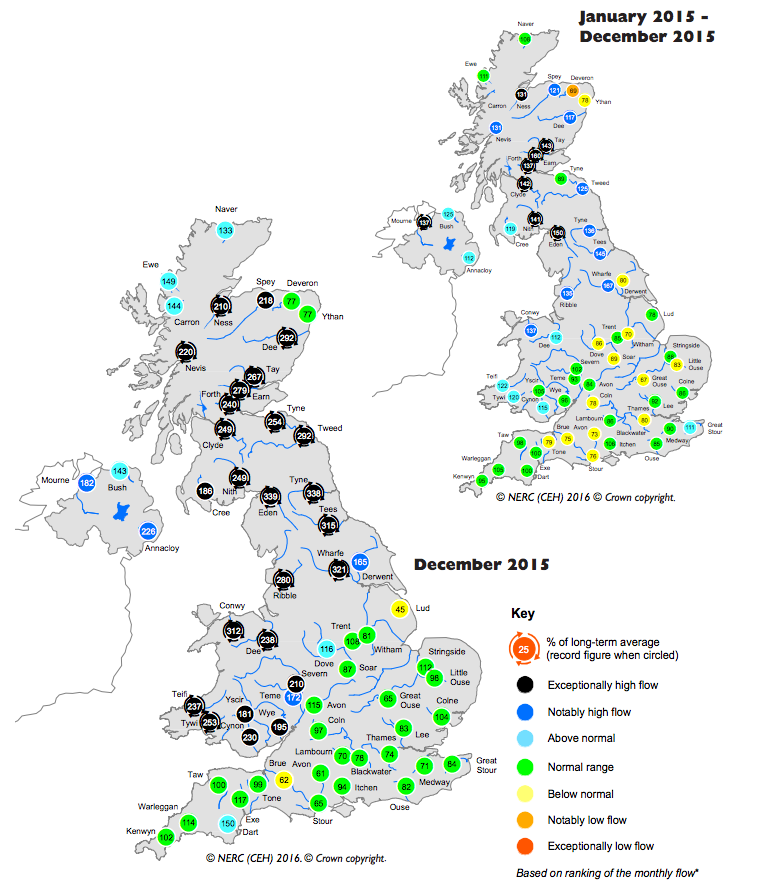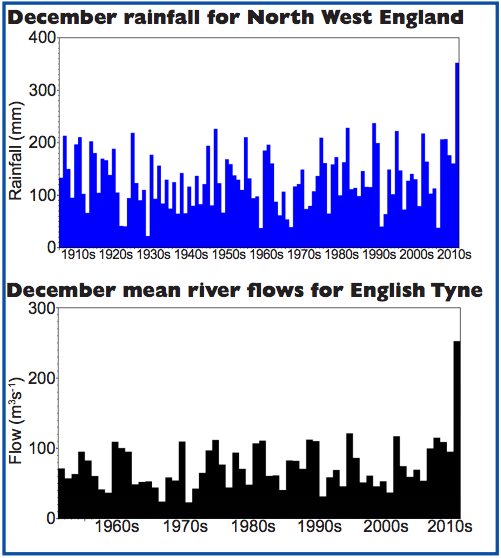
Guest post: Linking extreme rainfall, flooding and climate change in the recent UK deluges

Nick Reynard
01.15.16
Nick Reynard
15.01.2016 | 4:54pmNick Reynard is the Science Area Lead for Natural Hazards at the UK’s Centre for Ecology & Hydrology, the UK’s foremost authority on flooding science.
December was an extraordinary month for the UK. Battered by storms Desmond, Eva and Frank, most northern and western parts of the country registered more than double their average rainfall. England saw its three highest ever recorded river flows on the Eden, the Lune and the Tyne.
At the Centre for Ecology & Hydrology, we’ve been working on our latest monthly summary, showing how the storms, rainfall and flooding combined to create such extreme scenes across the UK in December. You can read the full report, published earlier today, on our website.
Coming so soon after record river flows and catastrophic flooding in 2009 and 2013/14, these events have inevitably prompted speculation that flooding is increasing due to climate change.
It is becoming normal after any major flooding event to ask the scientific community whether or not it was due to manmade climate change or, more correctly, whether the event was more likely because of it.
But this is not a simple question. To answer it, we need to first understand that rainfall and flooding are not the same thing. The media, politicians and others often conflate the two, which leads to confusion over the role of climate change in recent events.

December flow in UK rivers as a percentage of the 1971-2000 long term average. Source: NERC (CEH) Hydrological summary for the UK, Jan 2016.
Climate component
Our starting point is that the UK has become significantly warmer over the last few decades, and the link with anthropogenic emissions is unequivocal.
December 2015 in the UK was the warmest in the record dating back to 1910. It was also the wettest calendar month in the last 105 years, the Met Office recently announced.
In a warming world, we expect an intensification of rainfall since, put simply, a warmer atmosphere can hold more moisture.
There is mounting evidence for an increase in heavy rainfall in the UK over the last 40 years or so. In fact, the preliminary results of an attribution study released just yesterday claim to show human activity made the heavy December rainfall 50-75% more likely.

A map of rainfall across the UK in December 2015, with some areas recording a more than 300% increase compared to the long term average. Source: Met Office.
Looking ahead, we can use hydrological models to project what future changes in rainfall will mean for flooding in the UK. In most cases, these indicate increases in flood flows in northern England and Scotland.
This research, carried out by the Centre for Ecology and Hydrology, has been used to support the development of the Environment Agency guidelines on climate change and flooding.
But it’s a complicated issue. Increases in rainfall do not necessarily lead to equivalent increases in river flows or flooding. There are a number of factors than can mean the difference between one affected area flooding and another staying dry.
Cause and effect
The response of an individual catchment to changes in rainfall depends on its specific characteristics – things like the catchment size, steepness, soils and geology.
Some catchments, for example, can reduce the effect of an increase in rainfall because they have additional storage available. On the other hand, other catchments can accentuate changes rainfall, producing a larger increase in peak river flows.
Because of these extra factors, the link between flooding and climate change is far less clear-cut than for rainfall alone. That’s why it’s important to look at the evidence available.

December rainfall for North West England and mean river flow for the Tyne. Source: NERC (CEH) Hydrological summary for the UK, Jan 2016.
One way to address the question is to look at long records of rainfall and river flow. A great deal of scientific research has used the data held on the National River Flow Archive to assess whether there are long-term trends in flooding in the UK.
This work is reviewed and published by CEH scientists, while an analysis of the flow and rainfall maxima was also published by CEH.
In general, the conclusion are counter intuitive. Based on river flows, it suggests there is little compelling evidence for any upward trend in long records of flood magnitude or frequency in the UK that can be attributed to climate change. Why?
The observational record of river flow in the UK is complicated because of the strong impact of natural climate fluctuations. Much of the research using very long records points to pronounced variability between decades, leading to ‘flood rich’ and ‘flood poor’ periods.
For example, the north and the west of the UK have seen an increase in high river flows associated with the positive phase of the North Atlantic Oscillation. The recent flooding has also occurred against the backdrop of a strong El Niño, which in early winter is generally thought to increase the likelihood of a positive NAO. But the link is complicated by lots of other factors.
When it comes to attributing any specific flooding event or cluster of events to anthropogenic climate change, that means it’s very difficult based on observational records of river flow alone. We need to use sophisticated modelling techniques that take into account all the relevant factors in order to undertake attribution studies.
Using this technique, the CEH and our partners published some research papers following the widespread flooding in 2000, which showed these events were more likely to have occurred because of humans’ influence on the climate.
We are currently working on a similar study for the Winter 2013/14 floods to supplement our review of the atmospheric and hydrological drivers that led to this flooding.
These types of study take time. As I write, it is not clear how much other factors contributed to the recent cluster of floods in the north-west, on top of the increased risk of heavy rainfall from climate change.
What we can say is that when it comes to communicating events like we’ve seen in the UK recently, it helps to be clear about the distinction between flooding and the rain that drives it.
-
Guest post: Linking extreme rainfall, flooding and climate change in the recent UK deluges
-
Nick Reynard from the UK’s Centre for Ecology & Hydrology on how December's storms, rainfall & flooding combined to create such extreme scenes in the UK

